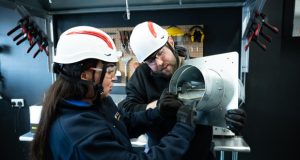Cromwell Polythene continues to strengthen its UK recycling and manufacturing operations, to help businesses protect themselves and the environment during the pandemic.
The family-run company, which has been in operation for 38 years, has seen increased demand for its range of essential products to help prevent the spread of infection. These include disposable gloves, aprons, and other PPE, as well as its range of sacks to capture clinical waste, including dressings and Covid-19 testing kits.
Investment has been made in new machinery and upgrades to existing machines at its UK manufacturing and recycling site, CPR Manufacturing. This has improved processes and increased energy efficiency to help meet the Climate Change Agreement obligations, as well as increasing capacity for film extrusion and bag making, in recycled and virgin polythene.
These products are used in diverse sectors, including cleaning, recycling and waste management, healthcare, foodservice and delivery, and local authorities. Products manufactured at the site include flat pack and bag-on-roll, for example, Cromwell’s Sansafe range of antimicrobial and scented liners, produced with 30 per cent UK-recycled PE film.
Cromwell’s free, used polythene recovery service is another way in which it helps customers to be more resource efficient. It keeps valuable resources within the circular economy by returning clean polythene packaging to the production cycle. Recovered material is recycled into new materials at the CPR Manufacturing site.
Cromwell Polythene is continually looking to enhance ways of working to improve customer experience and recently introduced a new, online order processing system. This automates and connects its sales, purchasing, operations, accounting, and stock management, ensuring an efficient and effective customer service.
James Lee, MD of Cromwell Polythene, said: “Our comprehensive range of products is designed to prompt responsible waste disposable and recycling behaviour, whilst helping to keep people safe and minimise infection risk.”





